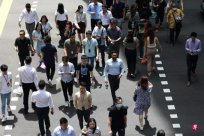
Studies released by the National University Yang Lingya Medical College on Monday (March 18) pointed out that high -temperature weather not only affects the health of the people, but also cause huge economic losses.In 2018, the average effective working time of high temperatures in Singapore fell 11.4%, and economic losses were about 1.18 billion yuan.The research team predicts that by 2035, the working hours caused by high temperature will increase to 14%, and economic losses will reach 2.22 billion yuan.
In addition to economic losses, research teams have found that long -term high -temperature environment may lead to a decline in the number and quality of male sperm, of which men aged 25 to 35 are lower than sperm quality of other ages.They believe that this is one of the factors that lead to low local fertility rate.
Professor Li Jiawei, the chief researcher of the research project and the director of the Human Research Center of the National University School of Medicine, pointed out that high temperature issues have always existed, but in recent years, people have begun to pay attention to the impact of high temperature on productivity and economy.question.
Throughout the development of history, human production activities and the rise and fall of civilization are not related to the climate.For long -term heat or cold areas, economic activities are affected and the development of civilization is also limited.Singapore is located in a high -temperature equatorial area. The hot weather affects production efficiency, especially outdoor operations.
Fortunately, the development of science and technology, such as the invention of air -conditioning, enables countries in the equatorial area to avoid high temperature roasting.When asked about the way of success in Singapore in an interview many years ago, Jianuo Li Guangyao pointed out that the tolerance of race is a prerequisite.When the interviewer asked whether there were other factors, Li Guangyao responded categorically: air -conditioner.He said that air -conditioning is a great invention in history. Its emergence makes the development of tropical possible and changes the nature of civilization.Almost all government departments, office buildings and shopping malls are installed with air -conditioning machines in Singapore.In addition, about 80 % of the families have air conditioners.The air conditioner allows the Chinese to avoid high temperature and change the way of life and operation.Enjoying air -conditioning in the mall is one of the ways to leisure Chinese people.
However, avoiding high temperature is not a sustainable way to reduce the risk of high temperature weather.The widespread use of air conditioners, push high carbon emissions, leads to rising temperatures; high temperature climate further increases the use of air conditioners and form a vicious circle.
Affected by the steady rise of global temperature and greenhouse effects, many places in Singapore have been suffered from heat.In May last year, the temperature of the Hongmao Bridge rose to 37 degrees Celsius, which is equivalent to the highest record 40 years ago.According to official forecasts, by 2045, Singapore's temperature may reach 40 degrees Celsius.
Like global climate change, the situation of high temperature climate in Singapore is severe, and it is necessary to increase efforts and reduce energy consumption.Taking the use of air conditioners as an example, the temperature of many office buildings, luxury hotels and shopping malls is very low. Employees must put on cold clothes to "protect the cold".Some tourists teased on the Internet, saying that the temperature of Singapore's air -conditioning is based on the low temperature between the lantern.
Secondly, it is necessary for Singapore to find more sustainable solutions to reduce the urban heat island effect produced by high -rise buildings and dense spaces.Studies have shown that the flow of people in the commercial area is dense, the distance between the high -rise buildings is small, and the heat of the air -conditioner emissions can increase the temperature by 1 to 2 degrees Celsius.
In this regard, the use of science and technology and the redesign of architecture will help reduce the impact of high temperature climate.For example, under the green home plan, the Housing Bureau tried the insulation paint with reflected solar thermal pigments.In addition, experts point out that buildings are facing north and south, which can obtain natural ventilation convenience and reduce sunlight.Setting solar panels on the top floor of the building or the exterior wall can also reduce calories.
The urban heat island effect has led the temperature in Singapore to rise faster than other countries.Research released by the National University of Medical College once again reflects the urgency of high temperature climate response.The threat of high -temperature climate is related to the survival and development of the island nation. It is necessary for Singapore to invest more resources to find feasible and affordable sustainable solutions to reduce risks and impact.When facing high temperature climate worldwide, these sustainable solutions believe that there is also market demand, so it is full of commercial potential.



